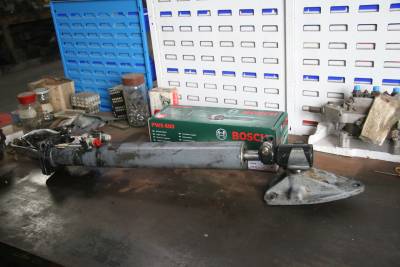When RM1872 was submitted for her MOT test it was noticed that the power steering ram was beginning to weep; not enough for a failure but certainly advice so we resolved to fix it.
We have been advised that this is normally the Dowty seals or "squiffy banjos" so we replaced the seals which improved matters greatly and we thought had cured the problem so she went for her test. This she passed but we had an advice on a weep from the grease nipple on the ram.
Removing the nipple shewed the leak wasn't from the ball joint side so the high pressure banjo was replaced with one from a new ram we'd borrowed.
This didn't fix the leak so we replaced the ram. Unfortunately the ram had been rebuilt incorrectly and oil sprayed out the piston rod dust seal when the steering was turned to the left! We weren't amused....
Examining the old ram carefully shewed that it's a power ram in a jacket and so any leak from the banjos could track between the ram and the jacket and emerge at any convenient point such as the grease nipple recess.
Since the seats appeared fine we polished up the banjos and the faces were far from flat. The old ram was refitted together with the polished banjos so hopefully we have now fixed the leak. Time will tell as the jacket looses its retained oil.
These notes apply to a Scania engined RM which has a separate power steering pump and header tank.
Please note this is a safety critical component and works must be carried out professionally. If in doubt DON'T - seek assistance.
We used the services of "RM Jack" who also worked for Ensign Bus.
To change the ram park the 'bus on the level and stop the engine. Put a "Not to be Moved" safety notice in the cab.
Remove the split pin from the ball joint and slacken the nut (11/8" AF socket - DO NOT REMOVE nut at this stage). With a suitable ball joint splitter (a fine wedge is best) release the steering arm from the ram.
Slacken all eight bolts fixing the ram to the 'bus ( ¾" AF spanner and socket required). Put a suitable container under the hose connections and slacken the banjo bolts (13/16 AF socket). When the system has drained out remove the banjo bolts and swing the hoses out of the way (examine for damage and replace if necessary including the copper washers).
Now remove three bolts from the front of the ram and three from the rear. With an assistant remove the remaining bolts and remove the ram from the 'bus.
To fit the new ram first attach it to the drop arm with one of the four bolts (do not tighten at this stage) whilst your assistant holds the ram then align the piston rod mounting plate with the chassis and loosely refit the lower bolt. Now refit the remaining six bolts and tighten all eight evenly. No torque is specified in the manual but the bolts need to be tight (use a standard ratchet to avoid over tightening). It is also advisable to use new nyloc nuts.
In order to refit the steering arm to the ball joint ensure the split pin hole is clean and where you can see it (see picture below). Fit the arm and tighten the castle nut finger tight ensuring the arm is fully located on the taper. Now tighten by no more than ½ turn and align to the next split pin hole; fit a new split pin.
Using "Brake and Clutch" cleaner ensure the banjo surfaces are scrupulously clean including those on the ram. Refit the hoses and banjos to the ram using new banjo bolt Dowty seals. Note that the aircraft parentage of the Routemaster has been carried over to the ram; the high pressure banjo is smaller than the low pressure one so the latter only fits the return (lower) port. The banjo to ram Dowty seal is also smaller on the high pressure (top) connection.
Tighten the banjo bolts firmly and ensure the hoses are parallel and not touching. Having checked all's tight refill the power steering header.
Start the engine and leave on tick over; check the header tank level and top up as necessary.
Check for leaks. If none then have your assistant turn the steering from left to right with the engine on a fast tickover. If all's OK then there should still be no leaks. Top up the header tank to correct level.
Remove safety notice and road test.
On return check for leaks; tighten connections if necessary - do NOT over tighten.
 |
 |
| The ram being fitted (note split pin hole at top) | Rear mounting plate being fitted |
 |
 |
| The cone joint for connection to steering arm | The ram on the bench |




